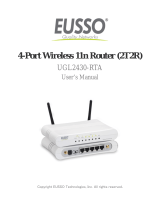
- IV -
5.14.6 Reboot ............................................................................................................... 107
5.14.7 Password........................................................................................................... 108
5.14.8 System Log........................................................................................................ 108
5.14.9 Statistics............................................................................................................. 109
Chapter 6. Configuration for Repeater Mode ...............................................................................111
6.1 Login ............................................................................................................................... 111
6.2 Status ..............................................................................................................................111
6.3 Quick Setup.....................................................................................................................112
6.4 Working Mode .................................................................................................................113
6.5 Network ...........................................................................................................................113
6.5.1 LAN.....................................................................................................................114
6.6 Wireless ..........................................................................................................................114
6.6.1 Wireless Settings................................................................................................115
6.7 DHCP ..............................................................................................................................116
6.7.1 DHCP Settings....................................................................................................116
6.7.2 DHCP Clients List ...............................................................................................118
6.7.3 Address Reservation ..........................................................................................118
6.8 System Tools.................................................................................................................. 120
6.8.1 Diagnostic .......................................................................................................... 120
6.8.2 Firmware............................................................................................................ 122
6.8.3 Factory Defaults................................................................................................. 123
6.8.4 Backup & Restore.............................................................................................. 124
6.8.5 Reboot ............................................................................................................... 124
6.8.6 Password........................................................................................................... 125
6.8.7 System Log........................................................................................................ 126
Chapter 7. Configuration for Bridge Mode .................................................................................. 127
7.1 Login .............................................................................................................................. 127
7.2 Status ............................................................................................................................. 127
7.3 Quick Setup.................................................................................................................... 129
7.4 Working Mode ................................................................................................................ 129
7.5 Network .......................................................................................................................... 130
7.5.1 LAN.................................................................................................................... 130
7.6 Wireless ......................................................................................................................... 131




















